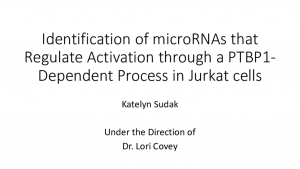Sudak, Katelyn: Identification of microRNAs that Regulate Activation through a PTBP1-Dependent Process in Jurkat Cells
Title: Identification of microRNAs that Regulate Activation through a PTBP1-Dependent Process in Jurkat Cells
Name: Katelyn Sudak
Major: Cell Biology and Neuroscience
School affiliation: School of Arts and Sciences
Programs: Aresty – Research or Conference Funding Recipient, School of Arts and Sciences Honors Program
Other contributors: Lori Covey, Usha Ganapathi, Diego Prado De Maio, Nicole Rothstein
Abstract: A variety of immune diseases stem from abnormalities arising from an absence or deficiency of CD40L. These abnormalities result in dysfunction of normal immunity. Autoimmune disorders, such as lupus, also display pathology and symptoms characteristic of abnormal immune functioning and can also have problems with CD40L expression. CD40L is regulated, in part, at the level of mRNA decay through a pathway involving the PTBP1 (polypyrimidine tract-binding protein 1) RNA-binding protein that stabilizes the CD40L mRNA by binding to a site in the 3’ UTR of the message. Previous work from our lab demonstrated that PTBP1 is required for multiple steps of T cell activation, in addition to CD40L expression, including cell proliferation, activation-induced cell death and expression of activation markers and cytokines. It is known that microRNAs (miRNAs) play a pivotal in the post-transcriptional RNA silencing through mRNA degradation or translational repression. Also, it has been shown that PTBP1 interacts with microRNAs to regulate expression of different genes. The purpose of this study is to determine whether potential microRNAs are regulating CD40L and other T cell activation responses through a PTBP1-dependent process. Experiments were carried out using two different Jurkat subclones, D1.1 and B2.7. The D1.1 subclone is more activated by multiple criteria, including the constitutive expression of CD40L, while the B2.7 subclone is less activated and does not express CD40L. Control lines, as well as lines with downregulated PTBP1, were used in this study. We hypothesized that if a microRNA is found to regulate T cell activation through a PTBP1-dependent process, there will be different expression patterns between the D1.1 and B2.7 cell lines. Additionally, if a microRNA is found to regulate CD40L expression, this target will be found in D1.1 and not B2.7 cells.
We suggest that the upregulation of particular microRNAs, in conjunction with PTBP1 expression, may be an important mechanism regulating the transition between non-activated and activated T cells. Overall, these findings contribute to the field because the results further the understanding of microRNA mechanisms relating to PTBP1 expression, and potentially T cell activation. These results can have important implications, as downregulating potential microRNAs may result in changes in T cell activation. How these results may be applied to CD40L expression has not been determined, however it is possible that results may be valuable for individuals with defective CD40L expression or autoimmune conditions. Through gaining this knowledge, it will be possible to identify novel mechanisms that impact the expression of CD40L.
